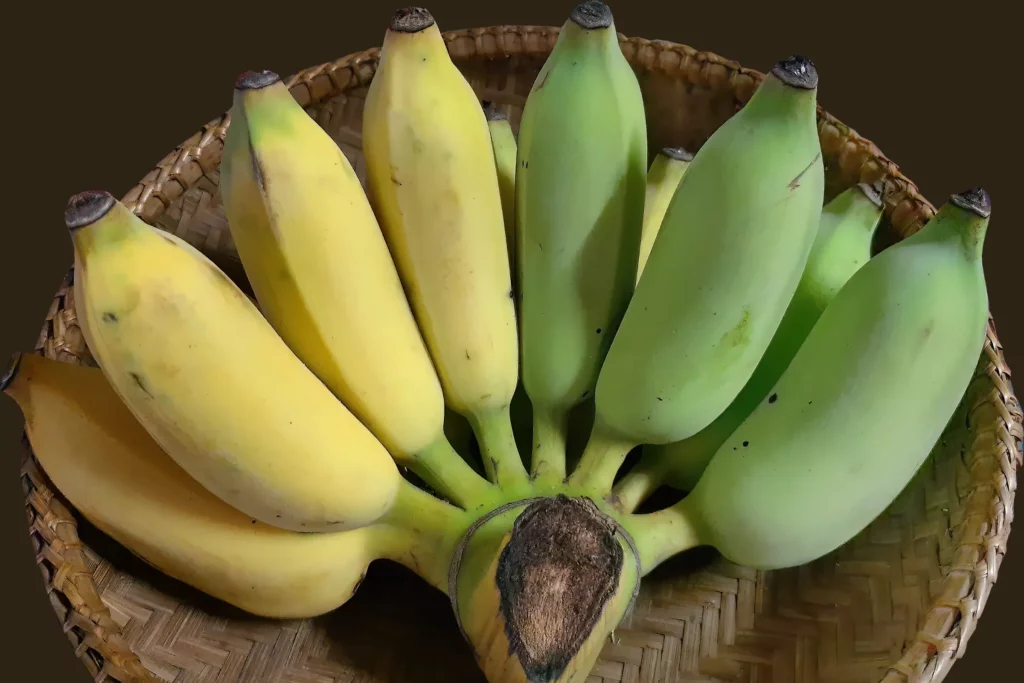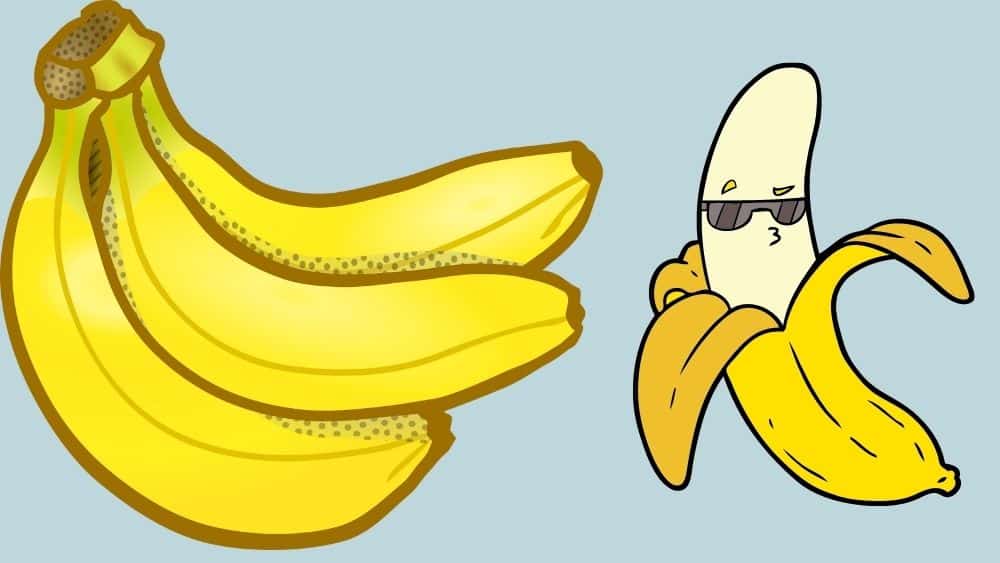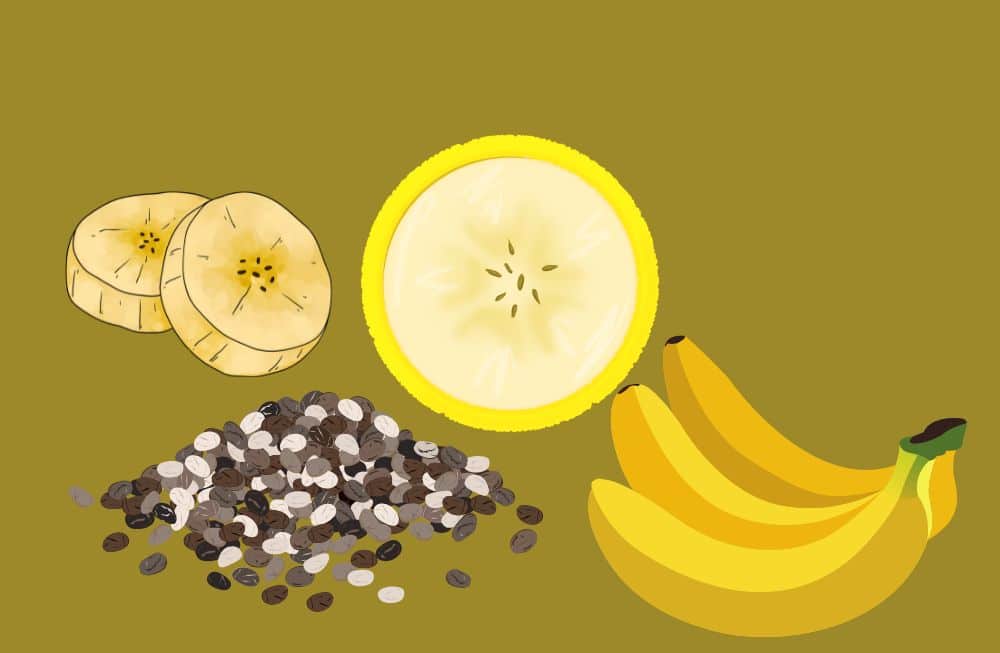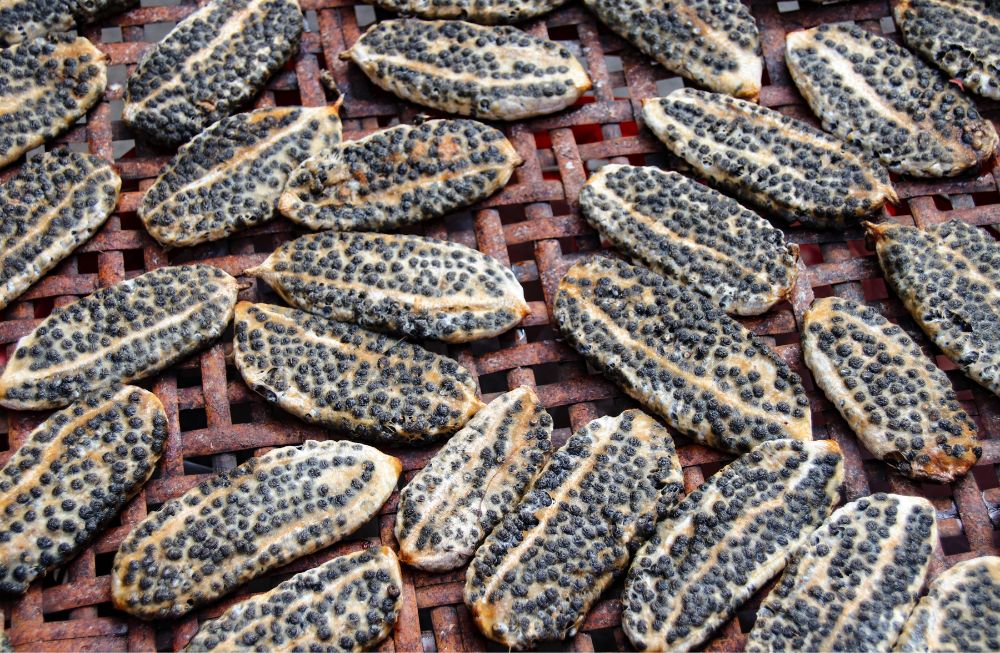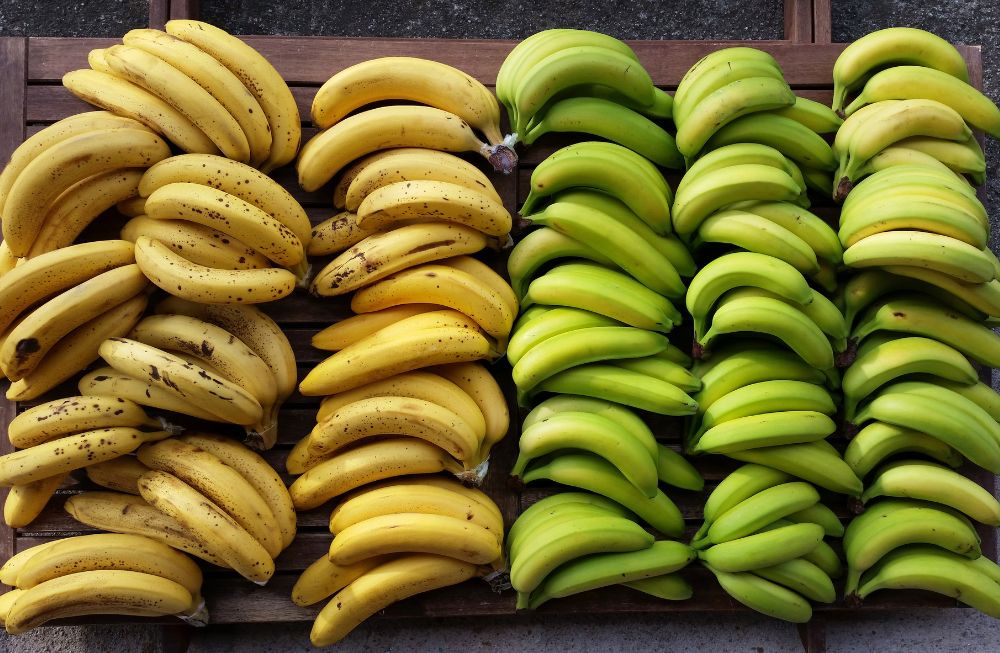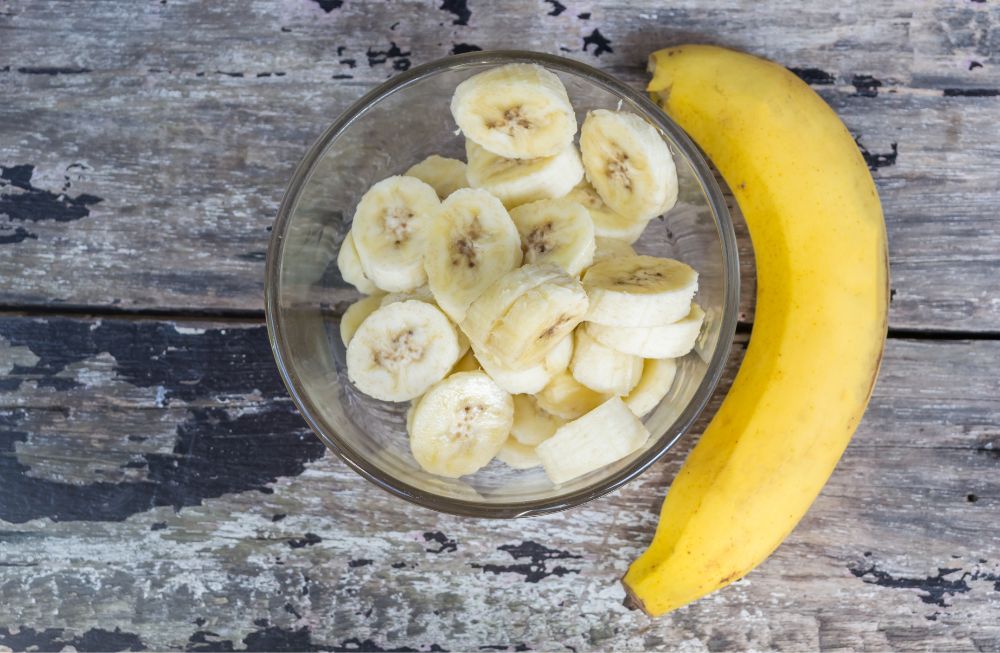Yes! Banana ripening is a chemical change in bananas that happens naturally. However, these chemical changes are triggered due to various natural factors, including humidity, temperature, exposure to ethylene, etc. After going through different phases and changes, a banana becomes naturally edible and ingestible with other characteristics and properties.
However, there’s more than just tossing around a complex scientific theory regarding the banana ripening process. It’s fascinating to experience how mother nature forces this fruit to go through an intriguing process.
Hence, on this page, you will be exposed to a detailing information related banana ripening process and how chemical changes during banana ripening. We have further added detail to make it informative and helpful. Therefore, Keep reading the article to catch every piece of information we have shared here.
What Is Banana Ripening?
Bana Ripening is a process in which a banana goes through a transition and breakdown of chlorophyll that triggers it to shift from a greeny look to a fully mature, yellow, and sweet typical version.
Visualize you have bought dozens of green and unripe bananas, and now you’re patiently waiting for their remarkable xanthic transformation. However, the change is more complex than you think while waiting for the bananas to ripen correctly.
A chemical war begins as time passes, with nature monitoring the process. It’s like each banana has a battle to win, fighting and defending until victory arrives. However, Chemical warfare can sometimes result in a draw or no victory.
To put it scientifically:- In this process, a banana undergoes a series of biochemical changes triggered by the plant hormone ethylene as it matures. This process supports a banana to properly go through physical and chemical changes and become a regular banana everyone enjoys eating.
Besides, a banana’s starches become much sweeter by going through a ripening process. At the same time, its sticky and rough flesh turns soft after enzymes break down the cell walls.
Regardless, a banana ripening process depends on various factors (e.g., humidity, temperature, exposure to ethylene gas). A warmer temperature boosts the ripening process, in which a banana turns mature much faster than usual. However, a drop in temperature can cause the process to be slower.
Note: It’s noteworthy to know that a banana can be digestible in its different stages of ripening. However, to enjoy a sweet version of a banana, you must let it go through the entire ripening process.
What Is Chemical Change In Banana?
Chemical changes in bananas refer to the alteration at the molecular level during ripening. These changes are the synthesis and breakdown of various compounds that make bananas undergo different chemical transformations.
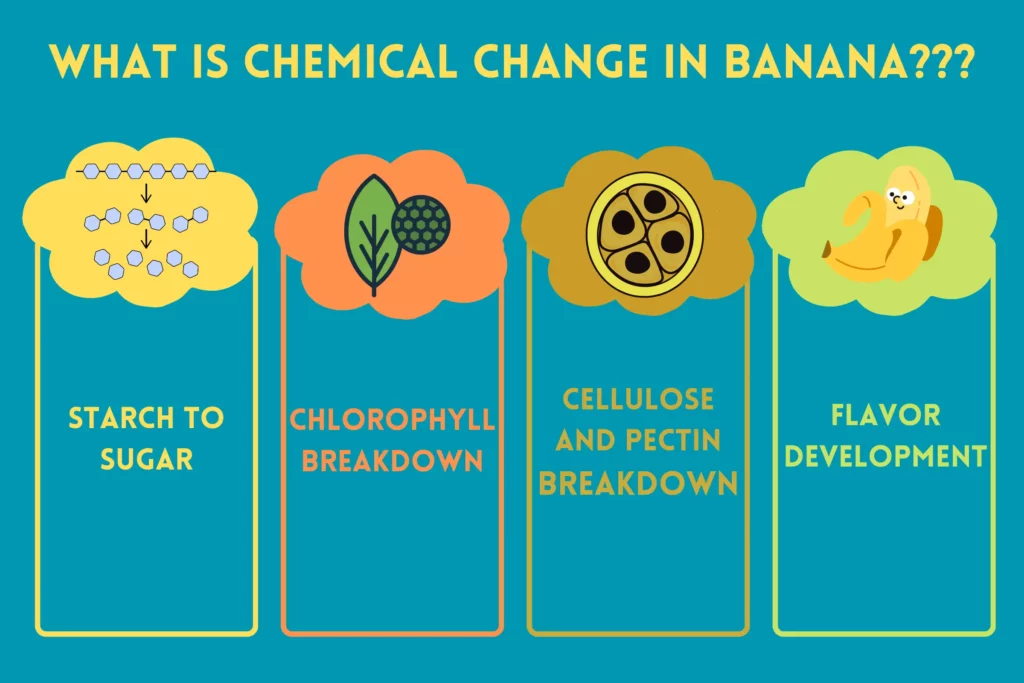
Here are some chemical changes that occur during banana ripening:
Starch to Sugar
In its green form, a banana contains a high level of starch, a complex carbohydrate. However, when a banana undergoes chemical changes, the enzymes break down and convert the starch into sweet.
Chlorophyll Breakdown
Banana chlorophyll breaks down in the ripening process. It causes the banana to gradually lose its color and become dull yellow. Usually, this breakdown in bananas is initiated by enzymes.
Cellulose and Pectin Breakdown
Cellulose and pectin are complex carbohydrates that break down during the ripening process, changing the structure of an unripe banana and bringing a soft and firm texture.
Flavor Development
Besides converting starch to sweetness, various volatile compounds (e.g., esters, alcohols, and aldehydes) are produced, bringing the flavors and aromas to fully ripen bananas.
What Chemical Changes During Banana Ripening?
A banana ripening process is a chemical change in the banana that adds different properties to it. During the procedure, various chemical substances in a banana are produced.
One important group of compounds involved in these changes is esters. Esters are volatile compounds that trigger fruity and sweet aromas. As the banana ripens, the concentration of esters increases, leading the banana to become more like a fruit.
Alcohols and aldehydes also play an essential role in the ripening process.
Alcohols, such as ethanol, accumulate during the ripening of bananas and contribute to the aroma. Aldehydes, like hexanal, are also produced from the breakdown of fatty acids and are responsible for the green aroma characteristic of raw bananas.
Furthermore, Aldehyde levels decrease as bananas ripen, leading to sweetness and aromatic notes.
What Causes Bananas To Ripen Faster
Humidity, a warm environment, and exposure to ethylene gas (A chemical compound viewed as a plant hormone) cause a banana to go through a fast ripening process. For example, it is possible to ripen a banana fast by leaving it in places with warmer environments.
Can Banana Ripening Goes Wrong?
Yes, the banana ripening process can go wrong due to various factors. Let’s look at some fundamental changes that can cause a banana ripening to go wrong.
Over-ripening: When a banana becomes over-ripe, it becomes too mushy and loses its good taste. Additionally, the peel may turn black or brown.
Under-ripening: If a banana is not appropriately ripened, it retains its green texture and lacks sweetness.
Uneven ripening: A banana may sometimes have under-ripe and over-ripe areas. In this case, the banana remains poor in taste and retains its green texture.
Spoilage: Like any other fruit, bananas can spoil and deteriorate if not stored correctly. They can develop mold or a fermented smell most of the time.
What Stage Of Ripeness Is Best To Eat A Banana
Most people like to eat a fully ripened banana. However, a banana can be digested and consumed in different ripening stages. Here are some standard stages of ripeness and their characteristics:
Green: A green banana is unripe and holds a firm texture. It is less sweet and inherits a starchy taste. Some people enjoy eating green bananas in dishes paired with veggies and meats where a firmer texture is preferred.
Yellow with green tips: In this stage, a banana inherits a balanced firmness and sweetness with a slightly tangy flavor. It’s a famous stage for those who prefer a less sweet taste and softer flesh.
Yellow: An entirely yellow banana is ripe and sweet. It has a softer texture, and its flavor is typically sweeter and mild. Most people prefer this stage for eating as a snack or incorporating it into recipes. People also love to add this to their daily diet for its valuable natural properties.
Yellow with brown spots: As the banana ripens, brown spots appear on the yellow peel. The flesh becomes softer, sweeter, and more fragrant. Some people find this stage the ideal balance of sweetness and texture, while others may not enjoy this.
Brown: A brown banana is overripe and may have a mushy texture. The flavor is delightful, and the banana can be used for baking or making smoothies. Some people enjoy eating overripe bananas as they are, while others find them too soft and prefer to use them in different recipes.
Eventually, the best phase of ripeness to feast a banana is personal and depends on individual taste preferences and the intended use of the banana. Worldwide, the yellow banana is the widely preferred stage of ripeness of a banana that is considered a fully ripe banana and is enjoyed by most people.
Note: The best stage of ripeness to eat a banana depends on personal preference. However, the typical yellow-colored bananas (Properly Ripened) are the most successful stage in which banana is sold in markets for people to consume.
Conclusion
Ultimately, the banana ripening process refers to a chemical change in which all the inherent properties of fully ripened bananas, such as sweetness and yellow coloration, manifest.
These chemical manifestations play a crucial role in the natural development of bananas, rendering them agreeable fruity, and fit for consumption.
The following article highlights various stages of banana ripening (e.g., fully ripened, under-ripened, overly ripened). These stages of banana ripening show how a banana undergoes different phases and is still edible.
Frequently Asked Questions (FAQ)
What Is The Best Way To Ripen Bananas
The best way to ripen bananas is by leaving them in a warm place. It triggered bananas to go through fast ripening while going through all the natural phases of banana ripening. However, there are other ways to ripen bananas, including using chemicals and manual procedures. But the outcome is that bananas can be dangerous for our bodies and health.
What Is The Reason For Bananas To Ripen
Different chemical releases and changes are the reason for bananas to ripen. These chemicals include the breakdown of chlorophyll, a series of biochemical changes, the breakdown of the cell walls, Cellulose and Pectin Breakdown, etc.
What Triggers The Ripening Process In Bananas?
Plant hormone ethylene, including various other chemical compounds and properties, triggers the ripening process in bananas.
What Changes Occur In A Banana During The Ripening Process?
Different changes occur in a banana during the ripening process that, includes changes in color, taste, and texture. A banana changes in color from green to yellow after ripening and tastes sweet with soft and edible fruit.
What Factors Influence The Ripening Process Of Bananas?
The ripening process of bananas is influenced by various factors, including humidity, temperature, and exposure to ethylene gas. Warmer temperatures speed up ripening, causing the banana to mature more rapidly.

